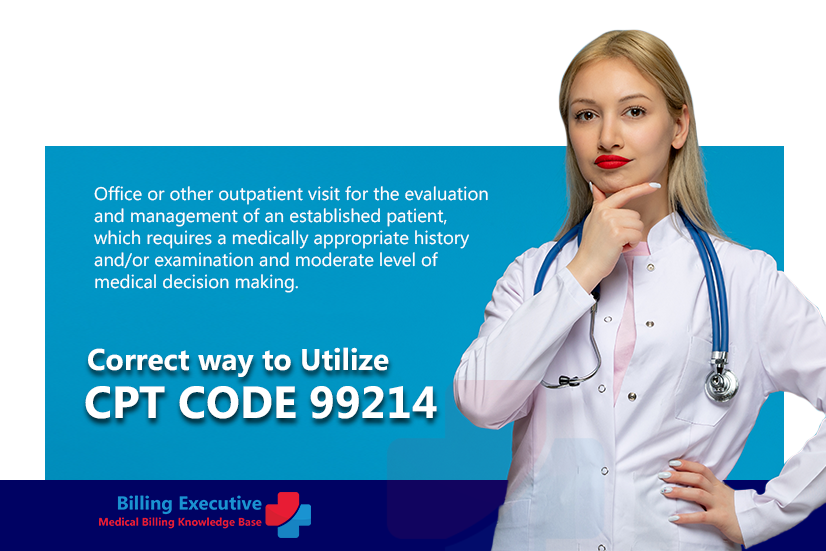99214 CPT CODE – Office/Other Outpatient Services (Established Patients)
Medicare only covers the medically required component of the appointment. Even if a comprehensive note is created, only the necessary services for the patient’s condition at the time of visit can be included in calculating the level of an E/M code. A chronological narrative of the progression of the patient’s current disease from the first indication and symptom or the last encounter to the present.

An inventory of bodily systems is collected through questions designed to detect indications and symptoms that the patient may be suffering or has experienced. These systems are classified as Constitutional (e.g., fever, weight loss). Cardiac; Respiratory; Digestive; Genitourinary; Skeletal; Integumentary (skin and/or breast); Cognitive impairment; Mental; Endocrine; Hematologic/Lymphatic; and Allergic/Immunologic
A comprehensive physical examination will include:
Extensive analysis of the damaged body part or organ system: These bodily regions are identified for examination reasons – The entire head, including the face; Neck; Chest (containing the breasts and axillae); Abdominal muscles; Genitalia, groin, buttocks; Back (including the spine); and Each Extremity
Body systems or significant organs that are symptomatic or linked: These organ systems are recognized for examination purposes – Constitutional (for example, vital signs and overall look); Cardiovascular; Respiratory; Digestive; Gastrointestinal; Skeletal; Skin; Neurologic; Mental; and Hematologic/lymphatic/immunologic.
Past, Family, and Social History (PFSH) is a survey of the following topics:
- History (the patient’s previous encounters with diseases, surgeries, injuries, and therapies)
- A family history (a study of medical occurrences in the patient and the family, including disorders that may be genetic or put the patient at risk) is required.
- History of Society (an age-appropriate review of past and current activities)
History in Detail: - The major complaint
- A long history of current disease
- Extensive system review
- Past family/social history that is directly connected to the patient’s concerns
Medical Evaluation Making of HIGH complexity entails two of the three steps listed below:
- Diagnosis and treatment options are extensive.
- A large volume of data must be evaluated.
- Complications and morbidity or death are at high risk.
A substantial quantity of data must be evaluated, which includes:
- Results of laboratory tests
- Diagnostic and imaging findings
- Notes/charts from other professionals (e.g., PT, OT, consulting physicians)
- Diagnostics or lab tests that must be conducted
Complications, morbidity, and death are at a moderate risk:
- Comorbidities related to the presenting issue
- The risk(s) of the diagnostic procedure(s) used
- The risk(s) associated with various management strategies
Further information:
Choose the code for the service based on the service’s content:
The length of the visit has no bearing on the standard of service to be invoiced unless more than 50% of the face-to-face time (for non-inpatient services) or more than 50% of the floor time (for inpatient services) is spent offering counseling or care coordination, as explained in CMS Publication 100-04.
Practitioners that choose to utilize time as the deciding factor:
- The documents MUST reflect the nature of the counseling in precise detail.
- Based on the overall length of the face-to-face interaction (floor time), the health history MUST be recorded in precise detail to support the code selection.
- Face-to-face time only relates to time spent with the doctor.
- Counseling by other personnel is not considered part of the face-to-face doctor interaction time. As a result, the time spent by other workers is not taken into account when determining the acceptable level of service.
- Comorbidities and other underlying conditions are not included when picking E/M codes, except their existence significantly enhances the difficulty of the medical decision-making process.
- Please remember that all services requested or provided to Medicare enrollees must be signed for. Signatures may be handwritten or digitally signed; stamped signatures are not permitted. You should not include late registrations in a health record but rather employ the signature authentication procedure.
To get properly compensated, you need medical billing and coding professionals familiar with these aspects and paperwork standards, or you can simply contact us. Our billers and coders have extensive experience, which alleviates your billing concerns and allows you to focus only on patient care. To learn more about our billing and coding services, please contact us at rcmexpertz@gmail.com
About us
Billing Executive – a Medical Billing and Coding Knowledge Base for Physicians, Office staff, Medical Billers and Coders, including resources pertaining to HCPCS Codes, CPT Codes, ICD-10 billing codes, Modifiers, POS Codes, Revenue Codes, Billing Errors, Denials and Rejections.
We have more than 10 years experience in US Medical Billing and hand-on experience in Web Management, SEO, Content Marketing & Business Development with Research as a special forte.
Learn More
15005 CPT CODE: Know your codes
RPM Care Management Services Coding Tips
Complete List of Place Of Service Codes (POS) for Professional Claims
